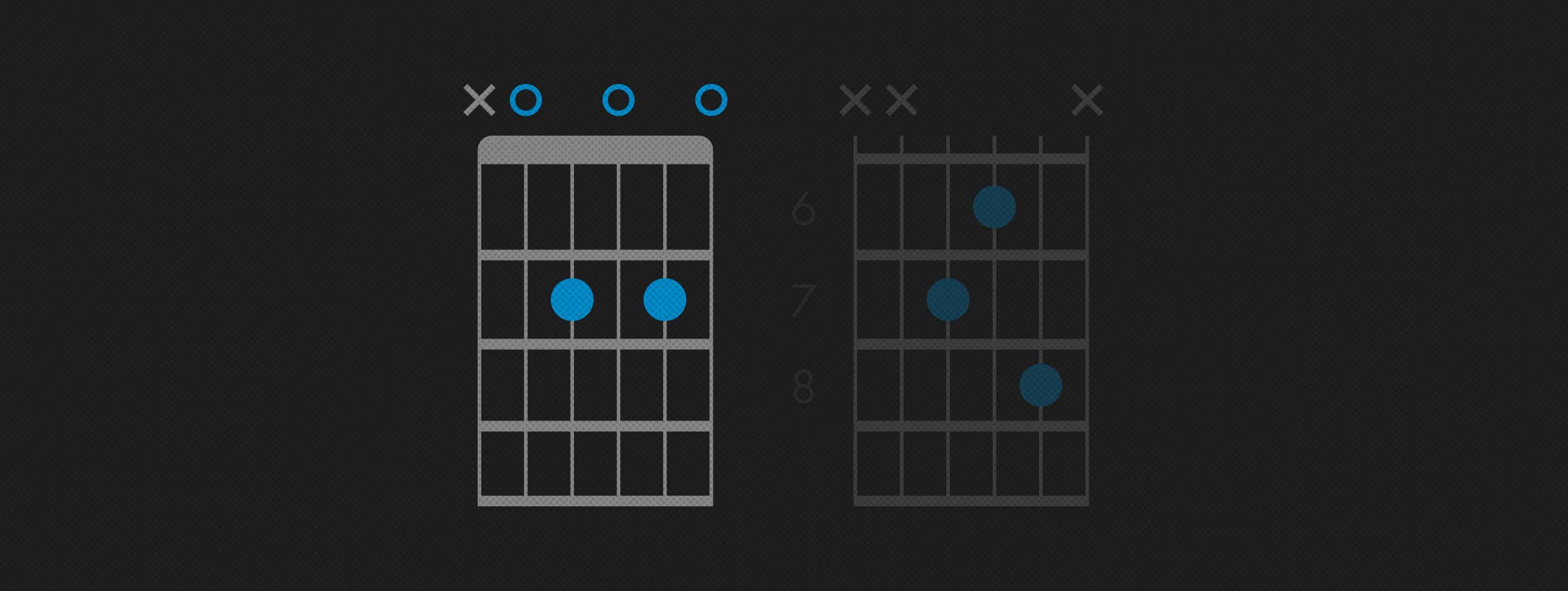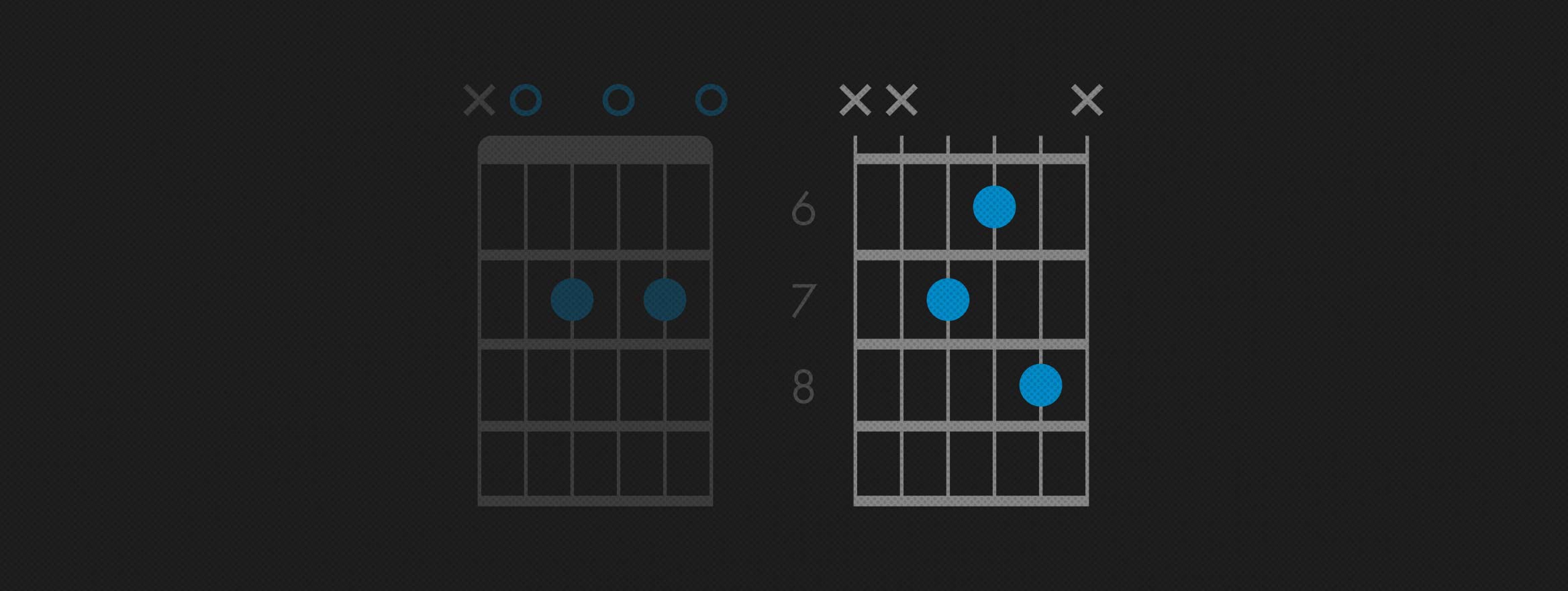
Sections
There are a few different ways to play the A7 chord and - spoiler alert - they are fairly easy, even for beginner guitarists.
The A7 chord doesn’t sound quite as cheerful as a major chord, but doesn’t sound nearly as mopey as a minor chord. This is due in part to it containing a sharp note in its composition (the C#).
This chord can be heard in songs in a multitude of genres, providing an unexpected shift in a song’s sound and adding some punch - no matter whether it’s played on the lower or higher register. Let’s learn how to play this versatile chord.
Two Different Ways to Play the A7 Guitar Chord
There are two different ways to play the A7 chord. Both make use of standard E tuning and are easy for beginners to master.
The first form of the A7 chord has you place your second (middle) finger on the second fret of your D string. Then, place your third (ring) finger on the second fret of the B string.
Index finger: 2nd fret of the D (4th) string
Middle finger: 2nd fret of the B (2nd) string
Strum five strings down from the A string

Another version of the A7 chord is a bit more difficult to play. Also played in Standard E tuning, this form of the A7 shifts position and has you place your first finger across the 6th fret and position your middle and pinky fingers on the 7th and 8th frets, respectively. In this version, you play just three strings down from the D string). This makes for a higher-sounding chord since it’s played further down the fretboard.
Index finger: 6th fret of the G (3rd) string
Middle finger: 7th fret of the D (4th) string
Pinky finger: 8th fret of the B (2nd) string
Strum three strings down from the D string

Songs That Use the A7 Chord
The A7 chord punctuates songs spanning a wide variety of genres. Listen for it in classic favorites or more modern melodies:
Don’t miss out!
Be the first to know about new products, featured content, exclusive offers and giveaways.
Rock Songs
The A7 chord can be heard in "Peggy Sue” by Buddy Holly, one of the Founding Fathers of rockabilly and rock n’ roll. A few short years later, the Beatles put their own distinctly British stamp on rock n’ roll, weaving the A7 into “I Saw Her Standing There.”
Another well-known British band, the Police (fronted by Sting before he became a solo artist) wove the A7 chord into their 1983 hit, “Every Breath You Take.” You can hear it kick in on the song’s bridge.
Folk Songs
One of the most iconic folk songs of all time, “Amazing Grace,” includes an ethereal A7 in its composition. The religious hymn was written in 1779 and has been covered by a diverse array of artists through the years, including Johnny Cash, John Legend, Willie Nelson and Aretha Franklin.
Pop Songs
American rock forefathers like Holly and leaders of the British Invasion like the Beatles knew the power of the A7 chord - and so did the King of Rock n’ Roll, Elvis Presley. Presley’s pop hits, “Heartbreak Hotel” and “That’s All Right” both featured the chord.
From kings to queens, Diana Ross and the Supremes intoned the A7 chord on their signature song, “Baby Love.”
In a similar Motown vein, you can hear the A7 in Martha Reeves & the Vandellas 1964 hit, “Dancing in the Streets.” The upbeat song became a civil rights anthem and was later covered by the Mamas & the Papas, the Grateful Dead, and as a duet with Mick Jagger and David Bowie.
Country Songs
The A7 chord’s mix of optimism and wistfulness can be heard in a number of similarly-themed country songs.
Listen for the A7 in husband-and-wife duo Roy Rogers and Dale Evan’s “Happy Trails,” which closed out the pair’s radio and television show.
Merle Haggard’s grizzled ode to disappointing your parents, “Mama Tried” also works in an A7 chord, as does Patsy Cline’s dreamy “Walkin’ After Midnight.”
Blues Songs
The A7 chord is a mainstay for blues legend, John Lee Hooker and can be heard in at least two of his most famous tracks, "Blues Before Sunrise"and "Boom Boom".
The chord fires a powerful shot and provides tension throughout Stevie Ray Vaughan’s angsty “Crossfire.”
The A7 can also be heard in other iconic blues songs, like Freddie King’s “I’m Tore Down,” and B.B. King’s lesson in living your art, "Why I Sing the Blues".
No matter what version of the A7 chord you choose to play, the more you practice, the more naturally it will come to you. Listen for it in different songs and start playing them.
If you'd like to learn how to play even more chords, browse Fender Play's chord library, learn about chord types, and find tips on how to master them. Also, if you're not a member yet, sign up for a free Fender Play trial.


